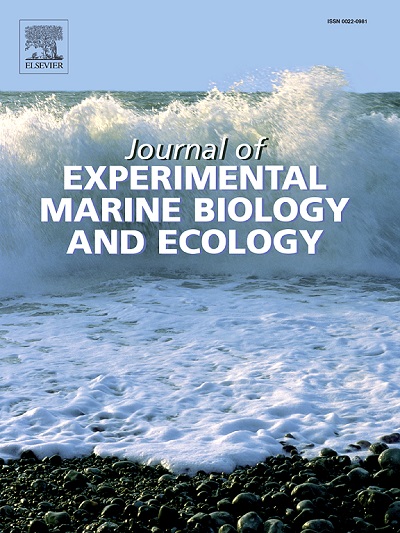塑料碎片的出现导致珊瑚鱼的视觉介导行为受损:视觉感官污染的证据
IF 1.8
3区 生物学
Q3 ECOLOGY
Journal of Experimental Marine Biology and Ecology
Pub Date : 2025-02-12
DOI:10.1016/j.jembe.2025.152089
引用次数: 0
摘要
巨塑性碎片(MPD)已成为无处不在的污染物,对海洋动物产生负面影响。MPD的大小、颜色和形状各异。MPD的视觉外观对依赖视觉的生物体的影响程度仍未得到很好的理解,特别是在其引起注意力分散、掩蔽和误导效果的潜力方面。在这里,我们假设,就像人类活动引起的其他干扰,如光、声和化学污染,改变了环境信息并影响了动物的行为,高度可见的MPD的存在可能会通过引起感官干扰来破坏视觉介导的行为。例如,MPD在视觉上与海景背景形成对比,可能会分散捕食者的注意力,因为捕食者使用视觉来搜索和捕捉猎物,这可能导致错误的猎物身份,降低捕猎效率。当猎物的颜色与MPD相匹配时,它们的对比度也会降低,从而掩盖了它们对捕食者的显眼性。在实验室条件下,我们通过测量中士(Abudefduf saxatilis)雀鲷在一定时间内消耗一定数量甲壳类猎物(Artemias spp.)的觅食效率来测试这种可能性。这是在五种处理下进行的,其中包括对照,白色MPD,绿色MPD和Ulva藻类的天然片段。我们还通过对隐藏但被淹没的塑料碎片进行处理,控制了MPD释放的化学物质的潜在干扰。当暴露于白色MPD时,雀鲷的觅食效率显著下降。具体来说,水族箱中对比度最高、与阿尔忒弥斯颜色最接近的碎片对鱼类的觅食效率产生了最大的负面影响。这些白色MPD的视觉特征似乎造成了感官污染效应,通过扭曲和/或掩盖相关的视觉信息,导致这种珊瑚鱼的视觉介导狩猎行为受损。对于许多海洋生物来说,塑料碎片可能与自然视觉线索大不相同,可能导致意想不到的后果,这一点仍未完全了解。本文章由计算机程序翻译,如有差异,请以英文原文为准。
The appearance of plastic debris results in impaired visually-mediated behavior in a reef fish: Evidence of visual sensory pollution
Macro-plastic debris (MPD) have become ubiquitous pollutants that can negatively impact marine fauna. MPD occur in a wide range of sizes, colors and shapes. The extent to which the visual appearance of MPD can impact organisms that rely on vision is still not well understood, specifically in terms of its potential for causing distraction, masking, and misleading effects. Here, we hypothesized that, much like other disturbances caused by human activities, such as light, sound, and chemical pollution that alter environmental information and impact animal behaviors, the presence of highly visible MPD could disrupt visually-mediated behaviors by causing sensory disruption. For example, MPD that visually contrast against the seascape's background could distract a predator that uses vision to search and catch prey, which may result in mistaken prey identity and reduced hunting efficiency. Prey could also become less contrasted when their color matches that of MPD, thus masking their conspicuousness to predators. Under laboratory conditions, we tested this possibility by measuring the Sergeant major (Abudefduf saxatilis) damselfish's foraging efficiency to consume a set number of crustacean prey (Artemias spp.) in a determined period of time. This was done under each of five treatments, which consisted of a control, white MPD, green MPD and natural fragments of Ulva algae. We also controlled potential interference from chemicals released by MPD by having a treatment of hidden, but submerged, plastic debris. The damselfish's foraging efficiency declined significantly when exposed to white MPD. Specifically, the debris that had the highest contrast in the aquariums and most closely matched the color of Artemias led to the greatest negative impact on fish's foraging efficiency. The visual characteristics of these white MPD appeared to have caused sensory pollution effects, by distorting and/or masking relevant visual information, which led to impaired visually-mediated hunting behavior in this reef fish. To many marine organisms, plastic debris might appear vastly different from natural visual cues, potentially leading to unexpected consequences, which remain incompletely understood.
求助全文
通过发布文献求助,成功后即可免费获取论文全文。
去求助
来源期刊
CiteScore
4.30
自引率
0.00%
发文量
98
审稿时长
14 weeks
期刊介绍:
The Journal of Experimental Marine Biology and Ecology provides a forum for experimental ecological research on marine organisms in relation to their environment. Topic areas include studies that focus on biochemistry, physiology, behavior, genetics, and ecological theory. The main emphasis of the Journal lies in hypothesis driven experimental work, both from the laboratory and the field. Natural experiments or descriptive studies that elucidate fundamental ecological processes are welcome. Submissions should have a broad ecological framework beyond the specific study organism or geographic region.
Short communications that highlight emerging issues and exciting discoveries within five printed pages will receive a rapid turnaround. Papers describing important new analytical, computational, experimental and theoretical techniques and methods are encouraged and will be highlighted as Methodological Advances. We welcome proposals for Review Papers synthesizing a specific field within marine ecology. Finally, the journal aims to publish Special Issues at regular intervals synthesizing a particular field of marine science. All printed papers undergo a peer review process before being accepted and will receive a first decision within three months.

 求助内容:
求助内容: 应助结果提醒方式:
应助结果提醒方式:


